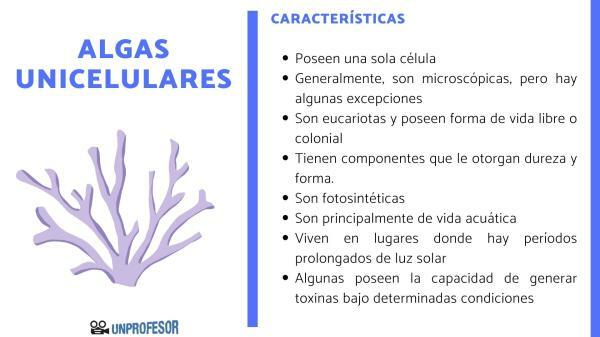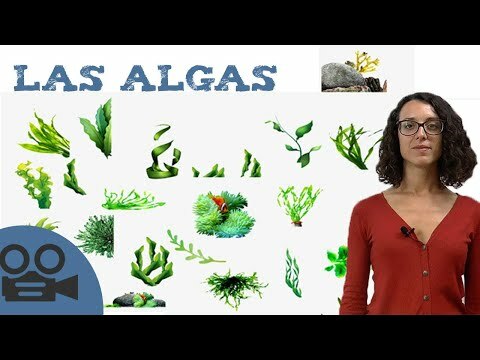5 characteristics of unicellular ALGAE

When we hear the word "algae", we generally tend to think of the typical green algae found at the bottom of the sea, in lagoons or rivers, organisms similar to aquatic plants. The classification of these living beings has always been the subject of discussion among scientists; some place them within the plant kingdom, others consider them typical of the Protist kingdom.
This happens, since algae, like plants, are autotrophic photosynthesizing organisms, they have colored pigments to capture solar energy and thus be able to produce their own food. In this article by a Professor you will learn what the characteristics of unicellular algae and examples of them.
What are the characteristics of unicellular algae.
As we mentioned before, the classification of the seaweed It has always been a controversy. In this lesson we will address algae as a varied group of stemless photosynthesizing organisms of eukaryotic and prokaryotic cellular nature (we include cyanobacteria).
Size
As its name indicates, this type of algae has a single cell, which is why we call them unicellular algae. Generally, they are microscopic, but there are some exceptions. Algae from hundreds of millimeters to several centimeters in size are known.
Morphology
Unicellular algae are eukaryotes, they have a free or colonial way of life, which means that they can group together to form colonies. Free-living unicellular algae can be mobile or attached to a substrate. Algae that are mobile do so thanks to a tail-shaped structure called a flagellum; they can also have contractile vacuoles.
Being unicellular organisms, they have in their structure, specifically in their cell wall, certain components that give them hardness and shape. These components vary in each species, we can find calcium carbonate, cellulose and silicon, When the algae die, their components settle to the bottom, becoming part of the sediment.
Feeding
Another characteristic of unicellular algae has to do with their diet. And all algae are photosynthetic, that is why in this group we can find algae with various pigments. But many of them have two forms of feeding: autotrophic photosynthetic, they can produce their own food from light energy, and heterotrophic, can incorporate organic matter from the atmosphere. Algae that have both forms of feeding are called mixotrophs.
Habitat
All algae are mainly aquatic life, we can find them occupying different spaces in saltwater and freshwater sources, or forming part of other aquatic organisms. Unicellular algae can live symbiotically with other species such as corals or anemones. They require certain environmental conditions to be able to proliferate, such as the incidence of light, temperature and salinity, among others.
We usually find this type of living being in places where there are prolonged periods of sunlight. They do not live in depths or murky waters, since the rays do not have the necessary wavelength.
Toxicity
Some unicellular algae have the ability to generate toxins under certain conditions. An example of this is red tide.

Examples of unicellular algae.
To conclude this lesson on the characteristics of unicellular algae, below we are going to give you examples of them that will help you better understand the lesson.
Cyanobacteria
They are also known as blue-green algae. They are bacteria, but were previously considered prokaryotic single-celled microscopic algae. They carry out photosynthesis with the release of oxygen, like eukaryotic algae and higher plants. They have blue or red pigments to capture solar energy. They do not have a mobile life form, since they lack a flagellum. They inhabit diverse environments, from ocean waters, fresh waters to humid terrestrial environments or extreme temperatures, they are thermophilic. Some types of cyanobacteria can produce toxins, this occurs when there is a large proliferation of this type of organisms under certain conditions of temperature and availability of nutrients.
Euglenophyta
Also known as green flagellated algae. Mainly, it comprises eukaryotic unicellular forms, as its name indicates, they have mobility by flagellum and green pigment, called chlorophyll, and they may have a heterotrophic feeding form. These algae have the particularity of inhabiting stagnant fresh waters, rich in organic matter. Example: Euglena.
Dinophyta
This type of algae is known as dinoflagella because it has two flagella; it is unicellular eukaryotic. They have various pigments that give them different colors, green, orange, among others. Some of these algae are bioluminescent, meaning they glow in the dark. Example: Noctilucas.
They inhabit marine waters and are known to be part of the phytoplankton. Some varieties are capable of producing toxins that accumulate in organisms such as fish and mussels; within this group we find the algae responsible for causing the "red tide."
Chrysophyta
Also known as golden, golden-brown or diatom algae. There are unicellular eukaryotic forms, free or fixed, they can also be found in the form of colonies. They inhabit fresh and salt waters and humid terrestrial areas. Most of this type of algae are part of freshwater plankton; marine species have the characteristic of having silica structures that give them shells. Example: Rhizochrysis.

If you want to read more articles similar to Characteristics of unicellular algae - examples, we recommend that you enter our category of biology.
Bibliography
- Gili J. M., Vendrell Simón B., Peral L., Ambroso S., Salazar J., Zapata R., Corbera J., González M. (2022). "Algae – The sea in depth" Institute of Marine Sciences. Spain.
- Cabral E. L. and Vallejos S. v. "Algae. Plant diversity." UNNE. Argentina.
- Gómez Luna L. M. (2007). "MICROALGAE: ECOLOGICAL AND BIOTECHNOLOGICAL ASPECTS". Cuban Journal of Chemistry, vol. XIX, no. 2, 2007, pp. 3-20.



